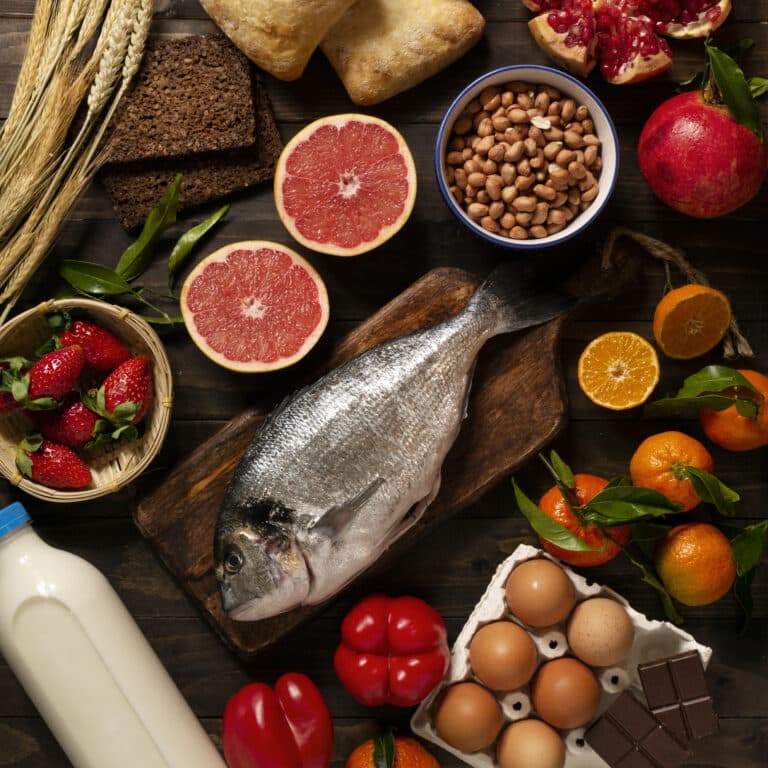What Does Sake Taste Like?
Have you ever had the pleasure of trying sake? For many people worldwide, sake is a much-loved beverage that can easily be enjoyed on its own or with food.
But if you’ve never experienced this unique and delicious drink before, you may wonder: what does sake taste like? In this blog post, we’ll answer this very question and explain why so many people are drawn to sip on this captivating drink from Japan. Read on for all the details!

Contents
What Is Sake?
Sake is a Japanese alcoholic beverage that is made from fermented rice. It is often referred to as rice wine, although the brewing process is more similar to beer than wine.
Sake is typically served chilled, at room temperature, or warmed, depending on the type of sake and personal preference. Sake is essential to Japanese culture and is often enjoyed during celebrations, religious ceremonies, and social gatherings.
What Does Sake Taste Like?
Are you curious to know what does sake taste like? Sake, often called Japanese rice wine, tastes unique and has a distinct flavor. Sake’s mild aroma is often compared to a very dry white wine, with a slightly fruity note.
Sake tastes like an astringent and savory flavor, and it has a variety of flavor profiles, depending on the type of sake. Cold sake is usually a lighter, more refreshing version with a mildly sweet flavor, while hot sake has a bolder, more robust flavor profile. Some people describe the taste of sake as similar to beer but with a smoother, more refined taste.
Sake can also have a slightly nutty undertone or umami flavor, which makes it great for pairing with sushi or other Japanese dishes.
Overall, sake is a clean-tasting, slightly sweet drink. If you enjoy trying new things and experimenting with different kinds of alcohol, giving sake a try should definitely be on your list!
What Does Cooking Sake Taste Like?
As for the taste of cooking sake typically has a mild, slightly sweet, and savory flavor with a subtle hint of alcohol. It is often used in Japanese dishes like stir-fry, teriyaki, and sushi rice to enhance the flavor and aroma of the dish.
Additionally, the alcohol content in cooking sake helps to tenderize the meat and remove any unpleasant odors.

What Does Beer-Sake Combination Taste Like?
Beer and sake combination can create a unique, complex flavor profile that blends the crispness and carbonation of beer with the smoothness and sweetness of sake.
Some people describe the taste as fruity and floral, with a slightly spicy aftertaste. Others enjoy the contrast between the caffeinated bitterness of a beer with the mellow umami of sake.
What Are the Main Components of Sake?
Sake is a traditional Japanese alcoholic beverage made from fermented rice. The main components of sake include:
- Rice: Sake is primarily made from special types of Japanese rice that are polished to remove the grain’s outer layers.
- Water: High-quality water is essential for making sake. It is used at various stages of the brewing process to help dissolve the rice and to adjust the alcohol level and acidity of the final product.
- Koji: Koji is a type of mold that is used to break down the starch in the rice into fermentable sugars.
- Yeast: Yeast is added to the mixture of koji and water to start the fermentation process. Different strains of yeast can impact the flavor and aroma of the sake.
- Alcohol: Sometimes, brewers add distilled alcohol to the finished sake to adjust the flavor and aroma, although this is not done in all types of sake.
- Flavoring agents: In some cases, flavoring agents such as shiso leaves or fruit extracts are added to the sake during brewing to give it a unique taste.
What Are the Different Types of Sake?
Sake can be classified into different types based on factors such as the type of rice used, the amount of polishing the rice undergoes, the alcohol content, and the brewing process. Some of the common types of sake include:

Junmai Sake
It is called pure rice wine, made purely from rice, water, yeast, and koji mold. Junmai has a rich and full-bodied taste, a bold umami flavor, and a slightly acidic finish.
Honjozo Sake
Honjozo sakes contain added pure distilled alcohol, which makes for a lighter and drier taste than Junmai. Expect a smooth and clean tasting, with a slight sweetness and a dry finish.
Ginjo Sake
Made with highly polished rice and fermented at colder temperatures, Ginjo sake tastes like delicate and fruity notes, with a pleasant aroma and a light, crisp finish.
Daiginjo Sake
Known for its superior quality, Daiginjo is crafted with high rice polishing and low fermentation temperatures. With a complex and refined taste, it has a fruity aroma and a smooth, sophisticated finish.
Nigori Sake
This unfiltered sake has a cloudy appearance due to rice particles. Slightly sweet with a thick and creamy texture, Nigori sakes have a mild flavor and can come in varying degrees of sweet and creamy taste.
What Factors Influence the Sake Flavor?
Several factors can influence the sake flavor, including:
Rice
The type and quality of rice used can impact the flavor of sake. Sake rice is usually larger grains with higher starch than regular table rice.
Water
The flavor of sake can be affected by the mineral and quality content of the water used in its production. Soft water with a low mineral content is preferred.
Yeast
Different yeast strains can produce distinct flavors and aromas in sake.
Koji
Koji is a type of mold that is used to break down rice starches into simpler sugars. The type of koji used can affect the sweetness and aroma of the sake.
Fermentation
The length of time and temperature at which the sake is fermented can also affect its flavor and aroma.
Filtration
The degree of filtration can impact the flavor and texture of sake, with less filtered sake having a more full-bodied flavor.
Overall, sake brewing is a delicate, multi-step process involving many different factors that can all impact the final flavor of the sake.
Is Sake Similar to Vodka?
Sake and vodka are both alcoholic beverages, but they are pretty different from each other. Sake is a rice wine originating in Japan, while vodka is an alcoholic beverage distilled from grains like wheat or rye.

In terms of taste, they are also quite different. Sake’s unique flavor is often described as smooth, slightly sweet, and with a distinctive rice flavor. On the other hand, vodka is known for its tastelessness and ability to blend well with other flavors.
So while both sake and vodka are alcoholic beverages, they taste pretty different from each other.
Is Sake Similar to Soju?
Sake is a traditional Japanese alcoholic beverage made from fermented steamed rice, polished to remove the bran. Conversely, Soju is a Korean distilled spirit made from grains like rice, wheat, barley, or even sweet potatoes.

Sake has a mild, sweet taste and is often served at room temperature or slightly warmed. It usually has an alcohol content of around 15-20%.
Conversely, Soju has a higher alcohol content, usually around 16-45%, and is often consumed chilled or with ice. It has a neutral taste and can be mixed with various flavors, making it a popular ingredient in cocktails.
What Is the Brewing Process of Sake?
The sake brewing process involves several steps, starting with carefully selecting high-quality rice. The rice is then polished to remove the outer layers, leaving only the starchy center behind. This is important as it allows the grain to absorb water more efficiently. The polished rice kernels are washed and soaked in water to enhance flavor.

The rice is steamed and cooled before it is mixed with koji, a mold that helps convert the rice starch into sugar. Next, the rice, koji, and yeast are all combined and left to ferment for several weeks with the addition of yeast.
After fermentation, the mixture is pressed to remove the liquid, which is filtered and pasteurized. Sake can then be aged or bottled right away, depending on the desired flavor profile.
Is Sake Good for Health?
Drinking sake in moderation can have potential health benefits. Sake is made from fermented rice and contains amino acids and antioxidants, which can help reduce the risk of certain diseases. Additionally, drinking sake is believed to promote cardiovascular health and reduce the risk of stroke.
However, it’s important to note that excessive alcohol consumption can have adverse health effects, so it’s best to enjoy sake in moderation.
What Is the Alcohol Content of Sake?
Sake’s alcohol content ranges from as low as 5% to as high as 20%, making it stronger than most beer but typically milder than most wine.
Undiluted sake has a high alcohol content, usually around 18-20%. This type of sake is typically served in small portions and is enjoyed as a digestif.
On the other hand, diluted sake has a lower alcohol content of around 10-15%. This type of sake is suitable for meals as it has a lighter taste and texture.
How to Drink Sake?
Sake is a Japanese rice wine with a mild, sweet, and almost fruity flavor. It is versatile whether served warm or cold – and can even be mixed into cocktails for a fun twist.

One way to serve sake is in the cold style. In this case, you should refrigerate the sake for some time before serving it. This way, the sake tastes crisp and refreshing, perfect for a hot day.
Place the sake bottle in hot water or gently warm it in a pan if you prefer a warm or heated style. Once slightly warmed, pour warm water into a pot and place the warmed sake glass into the pot. Warmed sake has a better taste when served in the Atsukan style. It’ll have a thicker texture and a smooth velvet taste and is perfect for colder seasons.

Some sakes have their best flavor when consumed in the traditional Japanese style known as Hiya-style. It’s served chilled but not cold. This style of serving sake allows you to appreciate its aromatic and flavor profile better. It has a smooth taste and texture.
What Is the Best Way to Store Sake?
Sake is a delicate beverage that requires proper storage to maintain its quality.
For best results, store an unopened bottle of sake in a cool, dark, and dry spot away from direct sunlight and heat sources. This will ensure your sake remains at its freshest! A pantry or a cellar would be ideal for this purpose. Unopened bottles of sake can last up to two years if stored under these conditions.
Once you’ve opened a bottle of sake, you should consume it within a few days or store it in the refrigerator. It’s best to seal the bottle tightly and avoid exposure to air to preserve its freshness. Additionally, storing an opened bottle of sake in the refrigerator can extend its shelf life by a few days.
Final Thoughts
Sake is a unique Japanese rice wine with a mild, sweet, and almost fruity flavor. The flavors of sake can vary depending on the type and how it’s prepared – from dry and light to richer and fuller-bodied. As such, there is something for everyone to enjoy when it comes to sake.
Whether served cold or warm, sake can create an enjoyable and flavorful beverage experience. Enjoy responsibly, and savor the unique flavors of sake!






